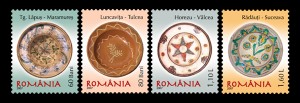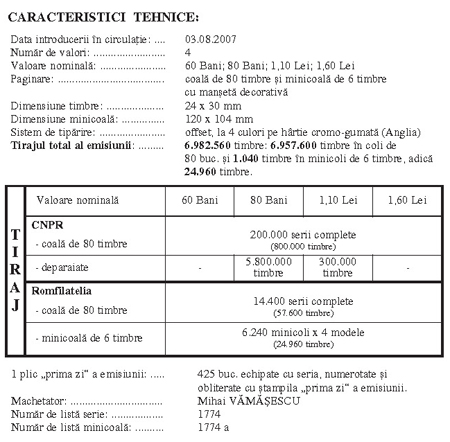 Romfilatelia, the specialized company in editing and trading Romanian postage stamps,
Romfilatelia, the specialized company in editing and trading Romanian postage stamps,
introduces in the postal circuit the stamps issue ROMANIAN POTTERY – Peasant dishes (III).Romfilatelia, the specialized company in editing and trading Romanian postage stamps,
introduces in the postal circuit the stamps issue ROMANIAN POTTERY – Peasant dishes (III).
The ornamental motives with which the plates are decorated are basically geometrical, but also phytomorphic, avimorphic, zoomorphic and anthropomorphic.
One of the oldest decorative geometrical motives is the triangle, which is also encountered on the prehistoric ceramics and appears in different forms (a series of triangles of the same size), “the saw” or “the wolf´s fang” (triangles arranged alternatively up-down).
The spiral particularly appears on the old ceramics of Cucuteni and Boian, but also on the
plates moulded in Vama, Horezu, Oboga, Romana etc. usually made from white clay. The spiral, although a very old motive, cannot be found in the occidental ceramics of the same period, not even in the later ones, such as the Mediterranean ones.
The “wave” or undulated line, often encountered elements, are applied on the
bottom and rim of the plates and form the structure of garlands or beanstalk with leaves and flowers placed on the same registers.
Along with the beanstalk and garlands, as a phytomorphic motive often encountered the
fir-tree tweak is, also used by the prehistoric pottery. The fir-tree tweak symbolizes perennial associated to the tree (life tree). Vine (a Christian symbol), and also wheat ears, clovers, clusters of grapes, buds, stylized leaves and flowers are also represented.
The avimorphic, zoomorphic and anthropomorphic motives are more rare and more recent and belong to the Byzantine tradition. Doves, fowls, fishes (Christian symbols) are
represented. While for Horezu ceramics the “rooster” motive is specific, for Oboga the “hen” is, and for Vama the stylized female silhouette, placed centrally, on the plate bottom.
The symbolic motives are very interesting, being connected to ancient, pre-Christian
believes, associated to the cult of Sun, which replaced the one of fecundity from the Bronze era. The Sun is stylized in rosettes, whirls, simple or concentric circles, spirals, or even in the anthropomorphised image of the star. The “laughing sun”, crying sun” as well as the stylizations of the Moon, transposed on flat plates particularly by the craftsmen potters from Horezu are the motives of great sensitivity.
On the postage stamp with the face value of RON 0.60 is illustrated a peasant dish made in Tg. Lapus-Maramures.
On the postage stamp with the face value of RON 0.80 is illustrated a peasant dish made in Luncavita-Tulcea.
On the postage stamp with the face value of RON 1.10 is illustrated a peasant dish made in Horezu-Valcea.
On the postage stamp with the face value of RON 1.60 is illustrated a peasant dish made in Radauti-Suceava.
The peasant dishes illustrated on the postage stamps of the issue are part of the Romanian Peasant Museum’s collection.
Issue date: 2007-08-03
















